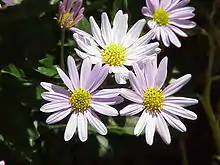Kalimeris
Kalimeris (or the Kalimeris Asters) is a genus of plants in the sunflower family.[2][3][4]
| Kalimeris | |
|---|---|
 | |
| Kalimeris incisa | |
| Scientific classification | |
| Kingdom: | |
| (unranked): | |
| (unranked): | |
| (unranked): | |
| Order: | |
| Family: | |
| Tribe: | |
| Genus: | Kalimeris (Cass.) Cass., 1825 |
| Synonyms[1] | |
| |
It was first described in 1825 by the French botanist Alexandre Henri Gabriel de Cassini (1781-1832).[2]
This genus occurs mainly in eastern Asia (China, Korea and Japan),[3] but is also naturalised on Hawaii.
They can grow to a height of 1-1.5 m. The foliage is herbaceous. The blue-green leaves vary per species and are smooth textured. They can be long and narrow, round with large teeth or lobed. The flower heads are solitary or in leafy flat-topped inflorescences. The disc florets are yellow, the ray florets are white, pink or purple.
The chromosome base number is x = 9. The genus's closest relatives are found in the Asian members of Aster and Heteropappus.[3]
- Species[1]
- Kalimeris altaica
- Kalimeris associata
- Kalimeris ciliosa
- Kalimeris coronata
- Kalimeris hispida
- Kalimeris incisa
- Kalimeris indica : Indian Aster
- Kalimeris integrifolia
- Kalimeris lancifolia
- Kalimeris lautureana
- Kalimeris longipetiolata
- Kalimeris mongolica : Genghis Khan Aster
- Kalimeris procera - China
- Kalimeris shimadae
- Kalimeris smithianus
- Kalimeris tatarica
 Kalimeris incisa - habit
Kalimeris incisa - habit K. mongolica - habit
K. mongolica - habit
References
- "Flann, C (ed) 2009+ Global Compositae Checklist". Archived from the original on 2014-12-10. Retrieved 2014-12-10.
- Cassini, Alexandre Henri Gabriel de. 1825. Dictionnaire des Sciences Naturelles [Second edition] 37: 464, 491 in French
- Hong-ya Gu and Peter C. Hoch (1997). "Systematics of Kalimeris (Asteraceae: Astereae)". Annals of the Missouri Botanical Garden. 84 (4): 762–814. doi:10.2307/2992027. JSTOR 2992027.
- Tropicos, Kalimeris (Cass.) Cass.